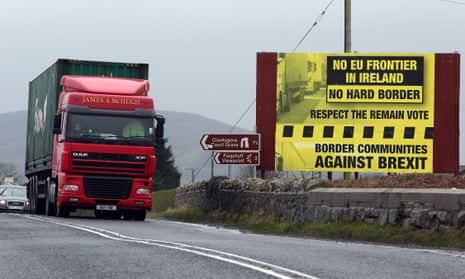Technology cannot make the Irish border completely frictionless after Brexit, a leading academic in Belfast has said.
Katy Hayward analysed every possible Brexit scenario for Northern Ireland and found that some checks and stops will be needed on the border after the UK leaves the EU.
“Smart border technology is primarily a means of enhancing efficiency. It cannot make a hard border frictionless,” said Hayward, a political sociologist at Queen’s University. “A hard border is not just determined by its visibility.”
The government has put its faith in technology to provide a way of squaring the Brexit circle in Northern Ireland, enabling an open border even if the UK quits the customs union and the single market.
But Hayward’s analysis shows it is regulation, not technology, that creates open borders. Even if HMRC develops a system to allow electronic pre-clearance for customs purposes, it would still not mean an open border.
“It does not obviate the need for inspections,” Hayward said in a presentation that was praised by the EU’s deputy chief Brexit negotiator, Sabine Weyand.
We do like slides here at team @MichelBarnier ... and these seem well done https://t.co/v8pJHTbFHL
— Sabine Weyand (@WeyandSabine) March 3, 2018
Senior figures in the haulage industry in Northern Ireland agreed. “Cameras might be able to recognise a number plate but they won’t be able to inspect what is inside a truck, nor will the freight owner necessarily know what truck his consignment ends up if it transits through a distribution centre,” said Seamus Leheny, policy director of the Freight Trade Association in Belfast.
Hayward tested four Brexit scenarios: remaining in the single market, remaining in a customs union, agreeing a free-trade deal with the EU or leaving with no deal.
She said there were already customs controls at EU internal borders for hazardous waste, counterfeit goods and smuggling. Stops for such matters are generally intelligence-led.
She said in the case of a customs union at least seven other border controls would be necessary, including for livestock and food, cash and capital, and work permits for EU citizens commuting across the border.
The biggest challenge would be agrifood, Hayward said. All livestock movement would have to be approved unless there was full regulatory alignment between the UK and EU. This would be unavoidable given the strict EU regulations around diseases such as foot and mouth. There would also have to be special arrangements for cross-border commuters who are not British or Irish. Hayward suggests this could affect, for example, a Polish or Spanish nurse living in Donegal and working in the Altnagelvin cancer centre in Derry, which is part of an all-island health service developed in the wake of the Good Friday agreement.
May has proposed mutual agreement on professional qualifications but this has not been agreed yet. This could have an impact on issues such as transport services, said Hayward.
“Take the train from Belfast to Dublin. Will the driver be able to cross the border? The common travel area only affects British and Irish nationals. So if you are an EU citizen you might need to be checked. Similarly, all the food sold on the train crossing the border will be subject to certification checks.”
